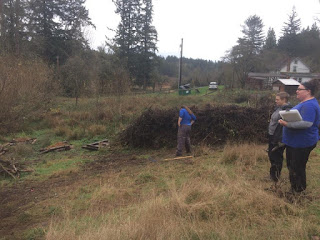

This fall quarter I have been involved in a wetland restoration project out in Woodinville on an old farm. This project was for my Restoration class taught at EDCC. I have logged 24 hours throughout the quarter working on the project with my classmates and other volunteers. The is site was infested with Himalayan blackberry, buttercup and reed canary grass on the edge of the wetland with a mixed diversity of natives plants like alder, black cottonwood, western red cedar, red twig dogwood, Pacific willow, salmonberry, lady ferns, skunk cabbage, black cap raspberry and red elderberry. The Himalayan blackberry was the biotic barrier that has inhibited natives to seed in. Our goals for the site were to completely remove the blackberry and plant natives which will provide shade to our site to eliminate the reed canary grass and buttercup over time.

Let me go back a bit...A hummock is basically mound of dirt in which you plant into, we did this because the soil is so saturated that it has very little available oxygen which roots need. Planting into a mound gives the plant just enough room for oxygen to be available while it establishes. This was something I learned during this project that really stood out to me.
We planted a variety of natives but mostly red twig dogwood and Pacific willow because they are fast growing and create a dense canopy to shade out weeds.
 We plan to incorporate woody debris for insects and animals to use. Critters were already starting to use piles of debris we made as shelter. While I was moving a pile of blackberry that had been sitting there for a few weeks I came across a home of little field mice and a salamander. I had seen a garter snake early in the quarter and numerous bird species that utilized the wetland.
We plan to incorporate woody debris for insects and animals to use. Critters were already starting to use piles of debris we made as shelter. While I was moving a pile of blackberry that had been sitting there for a few weeks I came across a home of little field mice and a salamander. I had seen a garter snake early in the quarter and numerous bird species that utilized the wetland.Question posed: How successful will this project be? What percent of plants will die the first year? Will it be one or two species that die or will it be area dependent? How long will it take for the plants to go tall enough to create a dense enough shade to combat the weeds that are already existing and yet to come? Will there be another weedy species which seeds have been lying dormant, waiting for the blackberry to be removed?
My teacher's email is: rodney.pond










That is really awesome! I would love to do something like that. Not nessisarily for a college class but just general volunteer work. Nice job!
ReplyDeleteThis comment has been removed by the author.
ReplyDelete